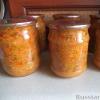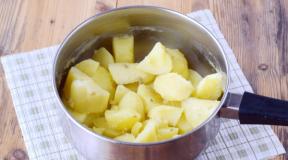Palm oil, harm. Palm oil in food: harm or benefit Palm oil: harm or benefit
Palm oil is obtained from the fruit of the oil palm tree and is used for cooking throughout the world. However, its production can be harmful to the environment, which is why products labeled “palm oil-free” have begun to appear in Western countries.
In Russia, such a mark also appeared, but for a different reason. Horror stories about palm oil are popular here: you can hear from journalists, State Duma deputies and even representatives of the food industry that palm oil is not digested and is not excreted from the body, prevents children from absorbing calcium, harms blood vessels and even causes cancer.

Let's deal with these myths separately.
"Not digestible"
Palm oil, like any other oil or fat, breaks down in the intestines into glycerol and fatty acids. “If a person is healthy and his pancreas produces enough lipase, digestion and absorption approaches 100 percent,” says gastroenterologist Alexey Paramonov. - If there is little lipase, excess oil will come out in the feces.
An example of oils that are not absorbed in the intestines are Vaseline and machine oil. But they are called oils only because of their external similarity, chemically being hydrocarbons. Nature did not expect us to ingest petroleum products, and provided enzymes only for oils and fats of plant and animal origin.”
“Deteriorates the quality of baby food”
Is it harmful for children to eat formula with palm oil? It is not the oil itself that is added to baby food, but palmitic acid isolated from it, and this is done to reproduce the composition of human breast milk, where this acid is also present.
There are studies showing that formula with palmitic acid from palm oil is less digestible than baby food without it. Acid from palm oil forms insoluble compounds with calcium, which are excreted from the child’s body in feces.
But the following position is no longer a myth:
Harmful to the environment
Russian media rarely remember that palm oil production is associated with a serious environmental threat.

To expand oil palm plantations, South Asia is destroying tropical forests that are home to endangered species such as orangutans and Sumatran tigers. People also suffer due to the fault of unscrupulous manufacturers. In Malaysia, while clearing new forest areas, farmers burned trees and drained peat swamps, which ultimately led to terrible fires on the islands of Sumatra, Borneo and Java.

Palm oil began to be widely used in the food industry relatively recently, but debate about whether it is harmful or beneficial has not subsided since then. On TV screens they often talk about its harmful properties; the media unanimously claim that it is the main cause of obesity, cardiovascular diseases and diabetes.
But what is the situation really like and is palm oil really so harmful or does it also have properties beneficial to human health? Let's look at this issue in detail.
How is palm oil made?
According to WWF (World Wildlife Fund), palm oil is found in more than 50% of food products. It is produced from the soft part of the oil palm fruit - this is what distinguishes it from flaxseed or sunflower oil, which are obtained from plant seeds. The product made from oil palm seeds is called palm kernel (it resembles coconut in its structural composition and properties).
The oil palm grows in Malaysia, Indonesia and African countries. Such localization of plantations, low labor costs and relatively cheap transportation significantly reduce the cost of finished products. In addition, one hectare of oil palm plantation can produce eight times more finished product than sunflower.
Raw butter is a very thick orange or red liquid with a pleasant nutty taste and smell, reminiscent of dairy cream; its chemical composition largely duplicates the usual butter.
Areas of use
Depending on the fraction (melting point), the product is used in various fields:
- Stearine is a solid substance with a melting point of approximately 47-52 degrees, similar in appearance to margarine;
- Actually, oil is a semi-liquid product that melts at 40-43 degrees Celsius;
- Palm olein is an oily liquid with a melting point of about 18-21 degrees Celsius, looks like a cosmetic hand cream.
Use in the food industry
The use of palm oil in the food industry began after American scientists studied the composition of the product in 1985. They also examined its properties in detail - up to this point it had been used exclusively for technical purposes.
Today, vegetable fat is used to make products with a long shelf life: confectionery, curd desserts, processed cheese, condensed milk, waffles, cakes and creams. In addition, it has the ability to improve the taste and appearance of products and reduce their cost.
Often it is used to replace milk fat, which is especially important for people who suffer from intolerance to certain components of milk.
There is no ban on the use of palm oil in any country in the world, but in the Russian Federation some time ago a bill appeared banning the use of the unrefined substance in the food industry. The ban was not adopted, but most manufacturers already “dilute” it with other vegetable fats, and on the product packaging they indicate that it contains a “milk fat substitute.”
Palm oil is also found in baked goods and confectionery products, sweet spreads, chocolate, processed meats, chips and French fries - this list is very extensive. Much controversy has flared up around the use of the product in nutritious milk formulas for infants, although its harm when used in baby food has not been proven.
Chemical industry, cosmetology and medicine
The ability to heal minor skin damage, moisturizing and nourishing properties allow the oil to be used in the production of creams for aging skin, healing ointments, and medications that are used to treat a wide range of cardiovascular diseases, gastrointestinal pathologies, and ophthalmological problems.
Palm oil, in addition to the food and pharmaceutical industries, is used by the chemical industry in the production of soap, detergents, decorative and ordinary white candles, and washing powders.
The effects of palm oil on the body
The benefits and harms of a product for humans depend on what type of product it is - red (unprocessed), refined and technical have different properties and are used in different areas of production.
It is important to take into account that the harm of palm oil to human health is often not determined by its composition, but rather by the chemical processing of raw materials in pursuit of reducing the cost of finished products.
Red oil
It is a natural plant product that is rich in natural red-orange pigment. It undergoes minimal processing, which allows it to retain many beneficial properties:
- it contains vitamins E and A, which allows it to effectively fight free radicals that provoke cancer;
- red palm oil has a positive effect on skin condition, nourishes hair, supports immunity, and also improves visual acuity.
But there are also a number of negative points:
- its consumption in large quantities can provoke diseases of the cardiovascular system or increase the risk of cancer;
- Palm oil (in large quantities) can cause significant weight gain. Due to its high melting point (40 degrees), it is digested somewhat worse than other products and, as a rule, is not completely eliminated from the body. When consumed excessively, most of it settles in the form of waste.
Vegetable fat does not accumulate in the body in such volumes that any special measures are required to remove it. Simply increasing the amount of natural foods in your diet is enough.

Refined and deodorized
In the food industry, as a rule, refined oil is used. It is an order of magnitude cheaper than unprocessed and can be stored longer, which can significantly reduce the cost of finished products and extend their shelf life, but in addition, it is practically devoid of all beneficial properties and is dangerous for the human body:
- A source of large amounts of saturated fat can cause the development of diseases of the cardiovascular system and worsen the condition of patients diagnosed with diabetes mellitus;
- Another negative impact is that by improving the taste of products, it provokes obesity;
- The harm of palm oil to human health is not limited to the likelihood of weight gain, because In addition, it is a carcinogenic product.
Olein is also used in the production of baby food, but not at all to reduce the cost of the finished product, as is commonly believed.
The source of palimitic acid, which is necessary for a child to fully develop and is contained in the required amount in mother's milk, cannot be cow's or goat's milk and vegetable fats, but palm olein can be brought closer to this substance. It is introduced into infant formula precisely with the goal of bringing the nutritional composition as close as possible to breast milk.
Hydrogenated
Hydrogenation is the process of adding carbon to make an oil solid. Any hydrogenated fat loses almost all of its beneficial properties and becomes an unhealthy product.
The product is hydrogenated for use in margarines and margarine mixtures. In this case, the harm of palm oil to human health is enormous, while hydrogenated products (including hydrogenated olive or vegetable oils) contain very few beneficial substances.
Technical
Industrial palm oil is used in the production of cosmetics, medicines, soaps, candles and washing powders. Its use in the food industry is unacceptable due to the fact that:
- the changed acid-base composition makes olein completely unsuitable for adding to food;
- it significantly impairs digestibility, deprives absolutely all beneficial properties and often provokes the formation of cholesterol plaques or even malignant tumors.
Most myths about palm oil are based on the erroneous claim that the product is banned in many developed countries. In fact, for example, in the USA, the volume of its use is growing year by year, and in the countries of Africa and the Asian region it is used daily by the majority of the population for cooking.
If non-technical oil and edible oil are used in the production of products, then it will cause no more harm than any other.
Most of the cheap dairy products in the Russian Federation have nothing to do with milk: expensive animal fat in supposed butter and pseudo-cottage cheese is replaced with cheap vegetable fat - palm fat.
Recently, officials have become concerned about this problem. There are a lot of proposals: to label all goods with “palm”, sharply increase import duties on tropical oils, place quotas on the import of palm oil into the country or ban it altogether. Only the cart is still there.
On a tropical needle
Palm oil has been used in the food industry since Soviet times - for example, in the icing of eclair cakes. But the palm boom came during the 1998 crisis: cheap food for impoverished Russians began to be massively prepared on the palm tree. “If in 1997 100 tons of palm trees were imported into Russia, then a year later - 390 tons,” the Federal Customs Service explained to AiF.
By the end of the 2000s. the problem worsened to the limit: manufacturers did not hesitate to make milk without milk, without indicating this on the labels. “There was a real battle going on in the industry,” recalls Larisa Abdullaeva, executive secretary of the Russian Dairy Union. “The technical regulations for dairy products of 2008, for example, were lobbied in such a way that it allowed to call palm products with terms close to dairy (cheese, sour cream, etc.).” It was only forbidden to fool consumers in 2012, by legalizing the concepts of “dairy-vegetable” (more than 50% milk) and “vegetable-dairy” (less than 50% milk) products.
 However, this was clearly not enough. Shadow business has long climbed onto the “palm tree” and has no intention of getting off it: the artisanal replacement of milk fat with vegetable fat produces super-profits. “Palm oil helps make a phenomenally cheap product: it costs about $570 per tonne - five times less than butterfat ($2,900),” says Roman Gaidashov, independent food quality expert. By passing off cottage cheese or butter as high-quality dairy, but adding from 60 to 100% palm substitute, the manufacturer turns into a millionaire in six months. It’s not for nothing that they say in Asia: having an oil palm plantation is more profitable than an oil well.
However, this was clearly not enough. Shadow business has long climbed onto the “palm tree” and has no intention of getting off it: the artisanal replacement of milk fat with vegetable fat produces super-profits. “Palm oil helps make a phenomenally cheap product: it costs about $570 per tonne - five times less than butterfat ($2,900),” says Roman Gaidashov, independent food quality expert. By passing off cottage cheese or butter as high-quality dairy, but adding from 60 to 100% palm substitute, the manufacturer turns into a millionaire in six months. It’s not for nothing that they say in Asia: having an oil palm plantation is more profitable than an oil well.
Palm Conspiracy
 Different countries are trying to fight exotic fat in their own way, but their efforts are virtually in vain. “For example, India and Thailand have introduced additional taxes on palm oil imports. In France, the issue of increasing the tax on products using palm oil by 300% is being discussed, says Pavel Shapkin, Chairman of the National Union for the Protection of Consumer Rights. - Over the past two years, supplies of palm oil to Russia from abroad have increased significantly. At the beginning of 2015, imports increased by 37% compared to the same period last year.” After the introduction of sanctions, domestic producers began to use chemicals more actively.
Different countries are trying to fight exotic fat in their own way, but their efforts are virtually in vain. “For example, India and Thailand have introduced additional taxes on palm oil imports. In France, the issue of increasing the tax on products using palm oil by 300% is being discussed, says Pavel Shapkin, Chairman of the National Union for the Protection of Consumer Rights. - Over the past two years, supplies of palm oil to Russia from abroad have increased significantly. At the beginning of 2015, imports increased by 37% compared to the same period last year.” After the introduction of sanctions, domestic producers began to use chemicals more actively.
In fact, no one knows the real level of food fraud in the country: most accredited laboratories are engaged by dishonest manufacturers. “The heads of the laboratories are lured by the manufacturers and make false reports that the products are clean,” one of the market participants told AiF on condition of anonymity. Even in courts between the state and businessmen, such “experts” end up on the side of business! It is curious that within the framework of the WTO, Russia was supposed to reduce the import duty on palm trees - from 15 to 5%. But she didn’t do this: WTO arbitration is currently underway. And, most likely, we will have to pay the WTO for the “palm tree” and reduce the duty.
5 dangers of palm oil
Manufacturers are pursuing their own profit - palm oil greatly reduces the cost of production and extends the shelf life of the product. But we, the consumers, suffer from this:
1. It is harmful to health. Leads to atherosclerosis, heart disease and can provoke cancer. A number of experts argue that palm oil is healthier than animal oil: it cannot contain harmful cholesterol. In Europe, dietary products based on “palm” are actively being made. “But in the European Union countries it is allowed to use palm oil with a peroxide value of 0.5 in the food industry. For Russia, the acceptable value is 10. The higher the peroxide number, the worse the oil. Throughout the world, such oil is considered technical, and we eat it!” - says P. Shapkin.
2. It deprives us of nutrients. Today, palm oil is everywhere (see info-graphic). “Vegetable fat”, “confectionery fat”, “vegetable fat substitute” - that’s all about it. They replace good and healthy components of food, and as a result, a person does not receive enough nutrients and vitamins from the same dairy products - no calcium, no microelements. The diet on one “palm tree” is extremely meager.
3. It helps to deceive us. Used for falsification, it is not processed properly and is not at all suitable for food. For legal palm oil, GOST clearly prescribes the permissible content of pesticides, toxic elements and radionuclides, and says that it must be deodorized and refined. For example, GOST requires storing edible palm oil in stainless steel canisters. But raw materials for counterfeit products are most often poured into plastic tanks that are not intended for this purpose. Leftover oil usually contains heavy metals: arsenic, cadmium, lead and mercury, as well as non-food chemicals.
4. It helps to rob us. In fact, products with palm oil are several times cheaper than natural ones.
5. It destroys nature. Asia is groaning from the popularity of palm oil: centuries-old forests are being cut down for plantations, and the animals living there are dying.

Click to enlarge
4Diets and healthy eating 21.09.2017

Dear readers, today on the blog we will talk about palm oil. How many rumors and various assumptions can be heard about him now, many of them are negative. Let's try to figure out where the truth is and where the lies are, what are the benefits and harms of palm oil for our health.
How is palm oil obtained?
First, let's talk about the technology for obtaining this product. Humanity has been using this oil for many thousands of years. This is vegetable oil. And it is a rare type of vegetable oil because it is hard. For the first time, archaeologists discovered a small vessel with the remains of this product in Egypt, but palm oil production was not established in this country, so experts concluded that palm oil was traded back in the era of the pharaohs.
This oil is obtained from the fruits of a special Guinea oil palm, which originally grew in Africa. Then it was taken all over the world. And now the lion's share of industrial production of palm oil occurs in Southeast Asia, Indonesia, the Philippines, and Malaysia.

The effect of palm oil on human health is an issue that has not been fully studied. Large world-famous companies such as Nestle use hundreds of tons of this product every year, but many people believe that palm oil can be harmful to health and lead to the development of various diseases.
Today's technology for producing oil is not particularly different from that which existed in ancient times. According to it, palm fruits are first ground and then heated. Under the influence of temperature, oil is released from the pulp, which is completely ready for further use. A similar method for obtaining palm oil is used in food processing plants.
Palm oil obtained in this way is in demand in the food industry: with its addition, various confectionery products, frying products, mayonnaise, spreads, table oil, processed cheese, etc. are produced. In addition, palm oil has found application in the cosmetics industry - it is included in creams, serums and masks for skin and hair.
Health benefits and harms of palm oil
Despite the widespread use of palm oil, the health benefits and harms of this product are perceived ambiguously by many.
Today you can often find various myths about palm oil that can be misleading. According to one of them, palm oil contains a large amount of cholesterol, so its excessive consumption can provoke various diseases, for example atherosclerosis. Based on USDA data, palm oil is completely cholesterol-free, so from this point of view the product is completely safe.

Benefits of palm oil
One of the factors that explains the benefits of palm oil is the record content of vitamin E in this product, namely tocotrienol, a substance that destroys free radicals and makes cancer cells lifeless. Therefore, palm oil can rightfully be called a fighter against cancer.
Quote More than 15 years ago, when rumors about the dangers and benefits of palm oil just began to spread, scientists conducted an experiment during which it was found that the product contains 14 times more vitamin A than carrots.
There is also an opinion that the harm of palm oil lies in the fact that the product undergoes hydrogenation - the process of turning liquid oil into solid. For example, hydrogenation is used to produce margarines and spreads. But the fact is that melting palm oil requires temperatures above 30˚C, so there is no point in hydrogenation.
The health effects of palm oil vary from person to person. For example, if the body has a sufficient amount of unsaturated fatty acids, palm oil helps break down toxins and toxic substances. Dosed consumption of palm oil improves immunity and promotes normal digestion.
Palm oil, which is found in various foods, contributes to:
- strengthening hair and nails;
- increasing skin elasticity;
- lowering blood pressure;
- acceleration of metabolic processes;
- improving vision;
- normalization of the nervous system;
- strengthening teeth and bones;
- reducing the risk of cardiovascular diseases.
But despite the obvious advantages of this product, palm oil also has its disadvantages, which will be discussed further.

The harm of palm oil
When considering the health risks of palm oil, the main factor that scientists and experts focus on is the high content of saturated fats in the product. Approximately the same amount of fatty acids is found in butter. When asking the question of whether palm oil is dangerous, the answer is: yes – if it is consumed in excess.
Scientists who have studied the composition of palm oil claim that it contains monosaturated acids: palmitic and stearic. These substances can harm the body, causing diseases such as atherosclerosis and thrombosis.
In addition, palm oil is often present in foods that are subsequently cooked. When exposed to high temperatures, product components become carcinogenic and can harm the gastrointestinal tract.
Palm oil in baby food
When studying the benefits and harms of palm oil in food, it is worth paying attention to how safe it is to give this oil to children. This nuance is especially important in relation to bottle-fed infants.
A small child has an imperfect digestive system - in the first year of life, his body lacks enzymes that ensure the digestion of many substances. That is why it is worth paying special attention to the question of why palm oil is dangerous in infant formula, so as not to put the child’s health at risk.
It is no coincidence that palm oil is present in many infant formulas. The fact is that mother's milk is a source of nutrients, vitamins and minerals necessary for the full growth and development of the baby. Studies have shown that breast milk consists of 20-25% palmitic acid, which is also found in palm oil. For example, cow's milk contains significantly less of this acid, therefore, at first glance, the presence of this component in baby food is extremely desirable.
However, many children who are bottle-fed and mixed-fed suffer from colic, diarrhea and constipation of unknown etiology. When asked whether palm oil is dangerous for infants, doctors answer positively and associate various digestive disorders with the content of this particular component in baby food.
Another thing to consider when purchasing infant formula with palm oil is that this product slows down the absorption of calcium, an essential substance for the growth of a child’s bones and teeth. Thus, it is better to choose palm oil-free blends. Today, many manufacturers have learned to synthesize modified palmitic acid, the digestibility of which is several times higher than that found in palm oil.

Myths about palm oil
Today, many people talk about the dangers of palm oil, but almost no one can say exactly why palm oil is dangerous for the body. Of course, there are some points, especially regarding the presence of palm oil in infant formula, but it is important to understand that many “facts” that are not related to reality have been created around this product.
In free sources you can find a wide variety of myths about palm oil, from the fact that palm oil contributes to the development of depression and stress, and ending with the fact that the product provokes cancer.
Here are the most popular myths about palm oil that have nothing to do with reality:
- The danger of palm oil is that it is not digested in the body. The myth is based on the fact that all fats are digested at temperatures above the human body. In fact, palm oil is not digested by temperatures;
- In civilized countries, the use of palm oil is punishable by law. It is not true. About 15% of all palm oil consumption occurs in the United States;
- Palm oil is obtained from the stem part of the tree. The product is actually squeezed from the fleshy part of the plant;
- Palm oil is suitable only for the cosmetic and metallurgical industries; it should not be present in food. According to statistics, almost half of all confectionery products are made with the addition of this product.
I suggest you watch a video in which Oleg Medvedev, Doctor of Medical Sciences, Professor at Moscow State University, debunks myths about palm oil. I highly recommend watching it.
In recent years, there has been much controversy surrounding the use of palm oil in the food industry. There are supporters of a complete refusal to use this product, proving that The harm of palm oil is undeniable, and, conversely, their opponents, who claim that it is not so harmful, and all the talk about its harm is a trick of those interested. You can understand this issue by analyzing all the available information.
What exactly is palm oil? This is one of the types of vegetable oil that is obtained from the fruits of the oil palm, or rather, from their fleshy part. The largest producers are Malaysia and Indonesia; they import the lion's share of palm oil. In fact, palm oil is not an oil at all, but a fat, the same as beef, for example. And the appetizing name “butter” is so as not to “scare away” us, consumers.
Why is palm oil so common?
Palm oil has become widespread because it has the ability to improve the taste and appearance of the product, as well as significantly increase shelf life.
Palm oil has a pleasant taste and aroma of milk cream, and therefore makes the products to which it is added tastier.
In addition, its addition to food products reduces their cost.
One of the key properties of palm oil is its high melting point - 38-40 degrees. Of course, it is beneficial for manufacturers to add it to their products. After all, it’s good when there are neat pastries and cakes on display that don’t flow or lose their shape even in hot weather, or cheese that is beautiful and tasty, but at the same time significantly cheaper than its dairy counterpart, or condensed milk, which has never even seen milk. .
It has also become indispensable when preparing fast food. Other vegetable fats (for example, the sunflower oil we are familiar with) have a very low “smoke point” - this is the name of the process when, during heating, oxidation products of unsaturated fatty acids, harmful to the human body, begin to actively form in the oil. In turn, palm oil, due to its high content of saturated fats, can be heated to a higher temperature without forming carcinogens. French fries and other fast food products (the same patties for hamburgers, cheeseburgers, etc., as well as potato chips) are most often fried in palm oil.
It would seem wonderful - carcinogens are not formed. Where is the harm in palm oil? However, heat resistance also has a downside - once palm fat enters the human body, it cannot be processed, since the temperature of the human body is lower than the melting point of the oil. It acquires the consistency of plasticine, which makes it much more difficult for the body to process it, and, as a result, “settles” on the walls of blood vessels.
What are the harms of palm oil?
Due to the high content of saturated fatty acids in palm oil (50%), it significantly increases the level of cholesterol in the blood. For comparison, in olive and sunflower oil these figures are 10% and 14%, respectively. Without harm to health, the consumption of foods containing saturated fatty acids should not exceed 10% of the total calorie content of the menu.
Palm oil is especially harmful when combined with carbohydrates, that is, in sweets.
In 2005, the World Health Organization thought about the dangers of palm oil and officially recommended reducing its consumption as one of the ways to prevent cardiovascular diseases.
In addition, palm oil is also harmful because it can significantly enhance the taste of the product to which it is added. A cake or candy containing palm oil will seem unusually tasty to you; you will want to eat it again and again, which can lead to overeating and, as a result, obesity.
Among other things, the body will receive a dose of saturated fatty acids above the permissible norm, and this is already an accumulation of cholesterol.
Another cautionary factor in consuming products containing harmful palm oil is that, in the pursuit of profit, manufacturers add too much of it to the food they produce. After this, it is stored longer and looks more appetizing, for example, like some ready-made muffins and rolls that have become so popular. And you, again, receive a shock dose of the product, which contributes to the accumulation of cholesterol. Therefore, be careful and read the ingredients on the label. If the manufacturing company has nothing to hide, it will not hide behind the broad concept of “vegetable fats”, but will indicate which ones were used. And it’s up to you to decide whether to buy such a product or not.
Harm of palm oil for children
Is palm oil used in baby food? The answer is clear - yes, they do. And all because natural cow's milk is significantly different from human breast milk and it is not always possible to give it to the baby. To avoid allergic reactions, manufacturers replace animal fats in mixtures with a combination of vegetable oils - sunflower, corn, soybean, including palm. However, palmitic acid, which is contained in palm oil, is poorly absorbed by the child’s body.
Human milk also contains palmic acid, but there are other components that help the baby process it.
This is again due to its high melting point: a child’s body is simply not able to, so to speak, “remelt” palm oil, much less extract useful substances from it. In addition, such mixtures have a significantly enhanced pleasant taste, and therefore the child develops a dependence on the product with palm oil. They like it more, it seems much tastier, and the baby will simply refuse healthier and more natural types of food in favor of products with harmful palm oil. As a result, you will be forced to buy a certain product, also increasing the profit of the manufacturing company. And it would not be a pity to increase the profit, if at the same time the child’s health did not suffer...
What foods most often contain palm oil?
Unfortunately, palm oil can be used during the preparation of almost all foods. It is used as an alternative to milk fat, and primarily it can be found in butter, margarine, spreads, condensed milk, dry cream, sour cream, ice cream, cheese, and other dairy products.
In addition, due to its use as a cheaper alternative to animal fats in the confectionery and bakery industries, palm oil is added to a variety of baked goods - buns, cookies, crackers, salty and sweet crackers, muffins, rolls, pastries and cakes, and so on. Also in the “risk zone” are various sweet spreads - chocolate, nuts, vanilla and the like; chocolate itself is no exception, as well as icing, chocolate and wafer bars. Chips and fries have already been mentioned.
How to minimize the harm of palm oil
Of course, try not to buy products containing it. This is difficult, considering that palm oil has captured the hearts of domestic producers. However, it's worth at least trying.
- First of all, read the label - sometimes the presence of palm oil is specified.
- The presence of nameless “vegetable fats” in the composition should alert you.
- Buy products made according to GOST, and not according to TU.
- Do not buy confectionery products with a long shelf life (months).
- Give up fast food - it will be beneficial in any case.
- Ideally, buy dairy products from friends in the village, and bake buns and cakes at home - they taste better that way.
Once upon a time, in a program about the dangers of palm oil and vegetable fats in general, they talked about a simple way to check chocolate for the presence of palm oil - hold a piece of chocolate in your hands. If it does not melt in your hands (and often in your mouth), this is a sure sign of the presence of palm oil.
Of course, it is difficult in the city to provide yourself with high-quality homemade products, but by being careful with your purchases, you can try to protect yourself from the “endemic” and so harmful palm oil.
About the benefits of palm oil
Is there anything beneficial about palm oil? To be fair, it should be said that palm oil contains large amounts of vitamin A, which is responsible for good vision, strengthens bones, is an antioxidant, and helps improve the condition of hair, skin, and nails. For comparison, the content of keratinoids in palm oil is 15 times higher than in carrots! However, in order for the human body to absorb this useful substance, it is necessary to be able to process the product containing it. As stated earlier, palm oil is poorly absorbed due to its high melting point, and therefore it is difficult to extract beneficial properties from it for the body.
There is a way out of this situation - processing of palm oil, during which its “liquid” oleic component is separated from the “solid” stearic component. Palm oil from its oleic component is more useful, is absorbed well by the body, and is also used for medicinal purposes. However, it costs several times more. And certainly not this kind of oil is added to food products, but regular oil, without processing, otherwise the cost of such products would be extremely high.
Unfortunately, you and I cannot escape palm oil and the harm it causes. Children will not stop eating chocolate and ice cream, and it is difficult for us to imagine the morning without a sandwich with butter and cheese. However, we should try to reduce its amount in our diet as much as possible.
Ksenia Poddubnaya “The Harm of Palm Oil” especially for the Eco-Life website.



















